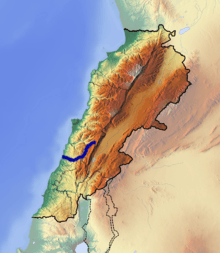Awali (river)
| Awali | |
|---|---|
 | |
| Country | Lebanon |
| Basin | |
| Main source | Barouk and Niha mountains, Lebanon |
| River mouth | the Mediterranean |
| Basin size | 294 km2 (114 sq mi) |
| Physical characteristics | |
| Length | 48 kilometres (30 mi) |
| Discharge |
|
The Awali (Arabic: نهر الأولي / ALA-LC: Nahr al-Awalī) is a perennial river flowing in Southern Lebanon.[1] In ancient times it was known as the River Asclepius. It is 48 kilometres (30 mi) long, originating from the Barouk mountain at a height of 1,492 metres (4,895 ft) and the Niha mountain. The Awali is supplemented by two tributaries, the Barouk and Aaray rivers. The Awali is also known as the Bisri river in its upper section; it flows through the western face of Mount Lebanon and into the Mediterranean. The Awali river has a discharge of 10.1625 m3/s (358.89 cu ft/s), it forms a watershed that has an area of about 294 km2 (114 sq mi).[2]
References
- ↑ Lebanese Ministry of Environment (2008). Lebanon State of the Environment Report (PDF). Beirut: Ministry of Environment. Archived from the original (PDF) on 2011-07-21. Retrieved 2010-08-03.
- ↑ Arab Resource Development (2003). INTEGRATED WATER RESOURCES MANAGEMENT IN CAMP AREA WITH DEMONSTRATIONS IN DAMOUR, SARAFAND AND NAQOURA MUNICIPALITIES (PDF). Beirut: Ministry of Environment. p. 132. Retrieved 2010-08-03.
Coordinates: 33°35′20″N 35°23′10″E / 33.5888°N 35.3860°E
This article is issued from Wikipedia - version of the 10/22/2016. The text is available under the Creative Commons Attribution/Share Alike but additional terms may apply for the media files.